Implementing Clean Architecture - Make it scream
04 Feb 2018How do I make my architecture “scream”?
According to Uncle Bob an architecture “screams” when it clearly expresses its core business purpose. The top level folder structure, the project/DLL names and the namespaces should express business aspects rather than frameworks or other details.
Athena is a web application implemented in ASP.NET MVC. But is this important? I could switch to Ruby on Rails or Node.js - it wouldn’t make any difference for the business. Why do we let such details impact our project structure so often?
Screaming project structure
Athena has three core use cases
- Show the backlog with projected team capacity (work balance we consider to be a different view on the backlog itself)
- Calculate a burn down chart
- Ensure backlog conventions via governance rules
In order to let my architecture scream I could create three projects/DLLs accordingly:

But there is one more thing to consider when setting up the project structure. The Dependency Rule.
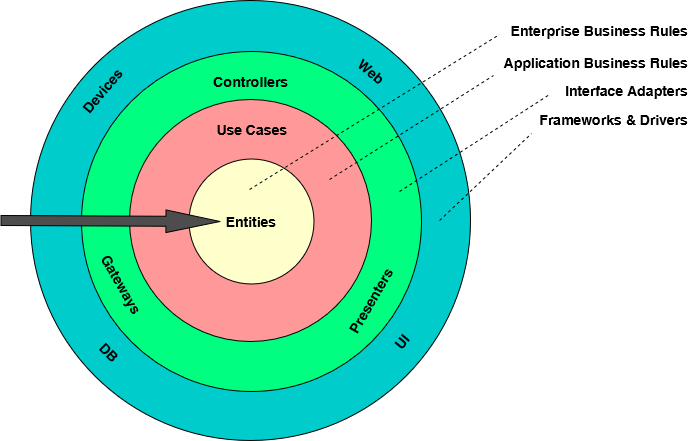
Dependencies between the four circles are only allowed from outer circles to inner circles. Creating clear boundaries between these circles is a simple way to support the Dependency Rule. E.g. when the project hosting the business rules does not reference any third party or framework library at all, this code obviously is free from such unwanted dependencies.
A minimalistic setup respecting both aspects discussed so far could look like this:
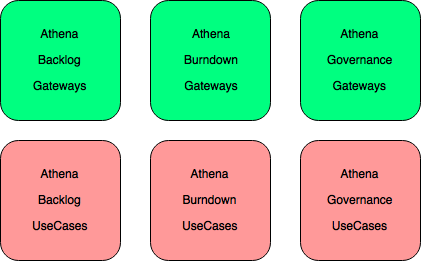
The “UseCases” projects will contain all the framework-free business rules. The “Gateways” projects will contain all the different kinds of “interface adapters” like Asp.Net controllers and repository implementations accessing the TFS. You could now argue that UI code (Asp.Net controllers) and data access logic (TFS repositories) should not live in the same DLL but honestly I don’t see much benefit right now in separating these aspects so I will keep them together. If I find a good reason later on this decision can easily be reverted.
What about the remaining two circles?
A “Frameworks” would contain extensions to the frameworks I use. As I don’t have such code yet I will not create a project for that circle.
And what about the entities? According to Uncle Bob there would probably be exactly one DLL hosting the enterprise wide business rules. When Athena wouldn’t had any code yet I would probably start with an empty DLL and carefully decide step by step which domain object is really worth sharing across the different features or sub-systems. From my past experience a little code duplication is easier to “fix” than a “to early” reuse.
As Athena has an existing code base already I can easily identify all domain objects related to teams as central entities. So I have created one “Entities” DLL which gives me now this structure:
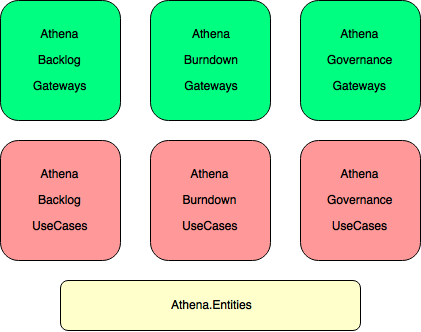
What about infrastructure and helpers?
Looking into my code base I find code which I want to reuse across the three sub-systems but which are NOT entities, e.g.:
- I have some functions which compile reusable HTML snippets.
- I have some functions to handle dates and times conversions consistently.
- I have some code which makes it easier to get the relevant data from TFS.
I would even consider such code as “framework extensions”. But if I would put it in the outer most circle, as per the Dependency Rule, I would not be allowed to use it from the “interface adapters” circle where I would need it.
So I decided to create another central “gateways” assembly for such shared “infrastructural” code, which finally gives my this picture:
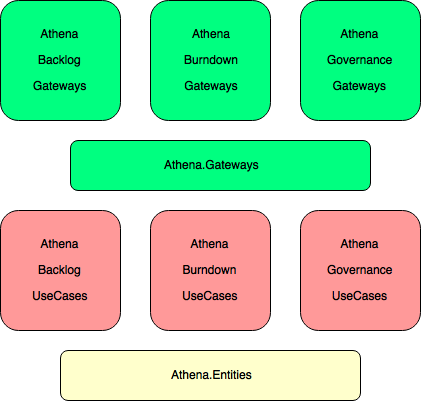
Naming conventions
The following summarizes the naming conventions I decided for in the context of the Athena project:
- Entities
- Project (DLL) and namespace end with “Entities”
- Classes would not have any specific convention
- Use cases
- Projects and namespaces would end with “UseCases”
- Classes would end with “Interactor”
- Gateways
- Projects and namespaces would end with “Gateways”
- Classes would end with role typical postfixes like “Adapter” or “Controller”
- Frameworks
- Projects and namespaces would end with role typical postfixes like “Web”, “IO” or “UI”.
- Classes would not have any specific convention
Does it have to be that big?
Finally I came up with eight projects/DLLs which is quite a number for a comparable small application.
For even smaller applications which “do only one thing and do it well” I would recommend to at least separate the business rules without framework dependencies from the code which will have framework dependencies. Such a setup would be less “screaming” but a “vertical slicing” would probably also be less needed in such small projects.
Easier dependency management in F#?
Did I told you already that Athena is written in FSharp? It is ;-)
The F# compiler has one nice feature which makes managing dependencies easier. The F# compiler processes code in the order it is defined in the project. That means code defined earlier in the project cannot access code defined later.
Using that feature I could put all code of one sub-system in a single project and still ensure the Dependency Rule. I just have to add the code in the reverse order of the Dependency Rule starting with the Entities. This way I could minimize the number of assemblies. Of course the risk remains that I use framework classes from the referenced libraries in the inner circles.
This would be then a question of discipline …
Update 2018-05-01
Frameworks
As discussed in “Are Asp.Net controllers “clean”?” I learned that it is better to draw a rather hard border between frameworks and interface adapters. This is probably best achieved by just not linking to framework DLLs/assemblies in the “interface adapters” project. This extends the project setup as follows:
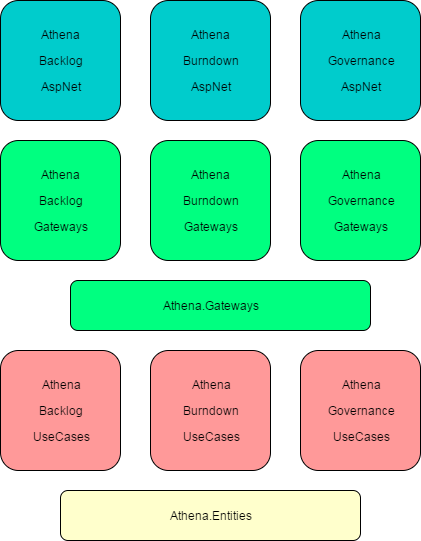
Composable UI
A question on StackOverflow reminded me to emphasize that a screaming architecture is not limited to the back-end! Modern desktop UI frameworks like Prism as well as modern web frameworks like AngularJS, ReactJS or VueJS are able to compose UIs from various, not “linked”, components.
Update 2019-04-28
After having read “Clean Architecture” the second time I found a great conclusion I want to share:
[…] lead to an inescapable conclusion: The component structure cannot be designed from the top down. It is not one of the first things about the system that is designed, but rather evolves as the system grows and changes.
Update 2022-09-19
I have created a YouTube video explaining in detail how I would setup a project following the Clean Architecture and how I would scale the structure as the code base grows:
The "Implementing Clean Architecture" series
- How to implement the Clean Architecture?
- Implementing Clean Architecture - An Overview
- Implementing Clean Architecture - Make it scream
- Implementing Clean Architecture - What is a use case?
- Implementing Clean Architecture - Of controllers and presenters
- Implementing Clean Architecture - Are Asp.Net controllers "Clean"?
- Implementing Clean Architecture - Frameworks vs. Libraries
- Implementing Clean Architecture - Case Study: Sending e-mails
- Implementing Clean Architecture - To use or not to use MediatR?
